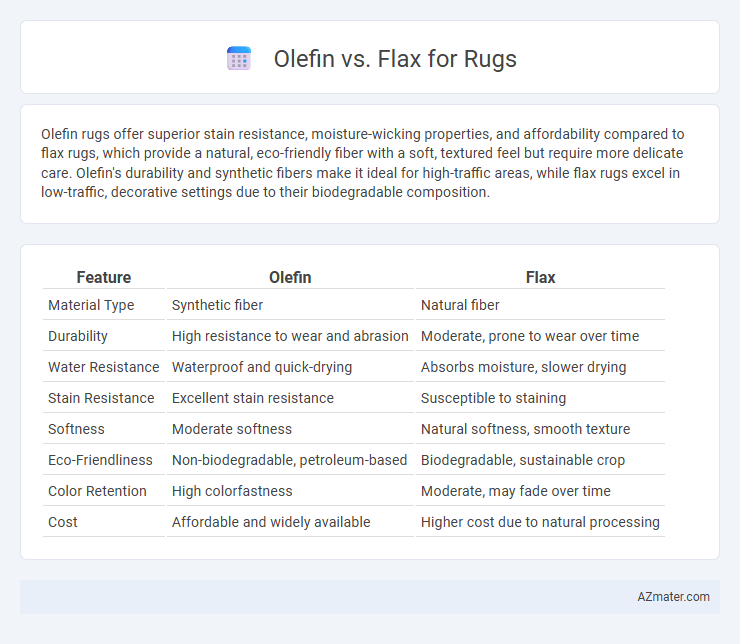Olefin rugs offer superior stain resistance, moisture-wicking properties, and affordability compared to flax rugs, which provide a natural, eco-friendly fiber with a soft, textured feel but require more delicate care. Olefin's durability and synthetic fibers make it ideal for high-traffic areas, while flax rugs excel in low-traffic, decorative settings due to their biodegradable composition.
Table of Comparison
| Feature | Olefin | Flax |
|---|---|---|
| Material Type | Synthetic fiber | Natural fiber |
| Durability | High resistance to wear and abrasion | Moderate, prone to wear over time |
| Water Resistance | Waterproof and quick-drying | Absorbs moisture, slower drying |
| Stain Resistance | Excellent stain resistance | Susceptible to staining |
| Softness | Moderate softness | Natural softness, smooth texture |
| Eco-Friendliness | Non-biodegradable, petroleum-based | Biodegradable, sustainable crop |
| Color Retention | High colorfastness | Moderate, may fade over time |
| Cost | Affordable and widely available | Higher cost due to natural processing |
Introduction to Olefin and Flax Rugs
Olefin rugs, made from synthetic polypropylene fibers, offer exceptional stain resistance and durability, making them ideal for high-traffic areas and outdoor use. Flax rugs, crafted from natural plant fibers, provide a rustic, eco-friendly aesthetic with a soft texture but require more careful maintenance due to their susceptibility to moisture and wear. Both materials serve distinct purposes, with olefin excelling in resilience and flax favored for organic appeal.
Material Composition: Olefin vs Flax
Olefin fibers, known scientifically as polypropylene, are synthetic polymers composed of long chains of hydrocarbons, offering excellent moisture resistance and durability for rugs. Flax, derived from the bast fibers of the Linum usitatissimum plant, is a natural cellulose fiber characterized by its breathability, biodegradability, and a rough texture ideal for organic-style rugs. The material composition of Olefin provides a lightweight, stain-resistant rug option, while Flax offers environmental sustainability and natural fiber aesthetics, influencing rug performance and care requirements.
Durability Comparison: Which Lasts Longer?
Olefin rugs exhibit superior durability due to their resistance to stains, moisture, and fading, making them ideal for high-traffic areas and outdoor use. In contrast, flax rugs, derived from natural fibers, offer moderate durability but are more susceptible to wear and environmental damage over time. For longevity, olefin outperforms flax by maintaining its appearance and structural integrity under heavy use and varying conditions.
Stain Resistance: Olefin or Flax Rugs?
Olefin rugs exhibit superior stain resistance due to their synthetic fibers repelling moisture and dirt effectively, making them ideal for high-traffic areas prone to spills. Flax rugs, made from natural fibers, tend to absorb liquids more readily, increasing the risk of permanent stains without prompt cleaning. For households seeking low-maintenance and stain-resistant flooring, olefin rugs provide a practical advantage over flax alternatives.
Comfort and Texture Differences
Olefin rugs offer a soft, smooth texture that feels slightly silky underfoot, providing comfort with resistance to moisture and mildew, making them ideal for high-traffic areas. Flax rugs, woven from natural fibers, have a coarser, more textured surface that enhances breathability and delivers a firm, organic feel, often preferred for warmer climates. The choice between olefin's synthetic softness and flax's natural texture directly impacts comfort, durability, and suitability for different living environments.
Maintenance and Cleaning Tips
Olefin rugs offer exceptional stain resistance and easy maintenance due to their synthetic fibers repelling moisture and dirt, making them ideal for high-traffic areas. Flax rugs, made from natural fibers, require gentle vacuuming and spot cleaning with mild detergent to prevent damage and preserve their delicate texture. Regular rotation and avoiding excessive moisture help maintain the longevity and appearance of both olefin and flax rugs.
Cost Analysis: Budgeting for Olefin vs Flax Rugs
Olefin rugs typically offer a more budget-friendly option, with prices significantly lower than flax rugs due to synthetic fiber production costs. Flax rugs, derived from natural fibers, often come with higher price points reflecting their durability, eco-friendliness, and artisanal crafting processes. When budgeting for rugs, cost analysis should consider upfront expenses versus long-term value, including durability and maintenance requirements.
Environmental Impact and Sustainability
Olefin rugs offer excellent durability and stain resistance but are derived from petroleum-based polymers, making their environmental impact higher due to non-renewable resource use and limited biodegradability. Flax rugs, crafted from natural flax plant fibers, provide a more sustainable option with renewable raw materials and greater biodegradability, reducing landfill waste and resource depletion. Choosing flax supports eco-friendly sourcing practices and lower carbon emissions compared to synthetic olefin alternatives.
Style and Design Versatility
Olefin rugs offer a wide range of bold colors and patterns due to their synthetic fibers, making them ideal for modern and vibrant interior designs. Flax rugs, crafted from natural fibers, provide a neutral, earthy aesthetic that complements minimalist and rustic decor styles. The combination of Olefin's durability with Flax's organic texture allows designers to select rugs that balance style innovation with timeless elegance.
Choosing the Right Rug: Olefin or Flax?
When choosing the right rug, Olefin offers exceptional stain resistance, durability, and ease of cleaning, making it ideal for high-traffic areas and households with pets or children. Flax rugs provide a natural, eco-friendly option with a unique texture and hypoallergenic properties, suitable for low-traffic spaces and those seeking sustainable materials. Consider Olefin for practical, long-lasting performance and Flax for aesthetic appeal combined with environmental benefits.

Infographic: Olefin vs Flax for Rug
 azmater.com
azmater.com